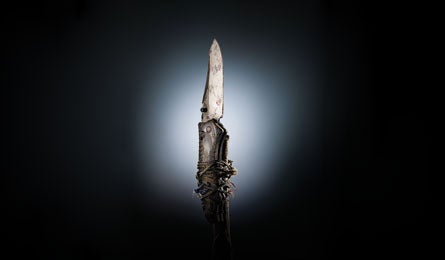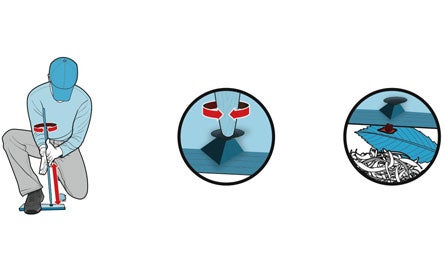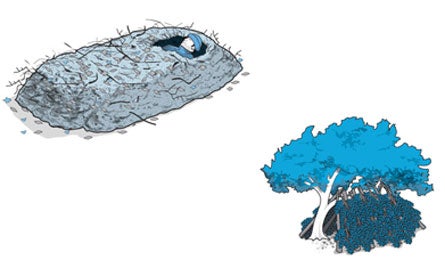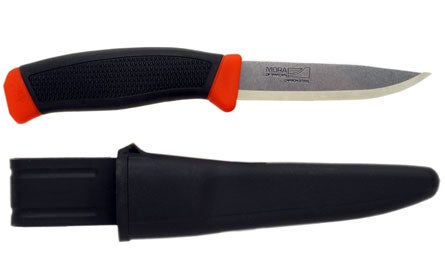Heading out the door? Read this article on the new Outside+ app available now on iOS devices for members! Download the app.

Learn these basic knife skills and survive almost anything.

Start a fire by using this simple technique.

Create two shelters with basic knife skills.

The Swedish Mora Knife (Courtesy)
Flagstaff, Arizona–based survival expert Tony Nester helps today’s tech-dependent humans get back to their primal roots with his popular “Knife Only” course. “A knifeless man is a lifeless man,” Nester says. Here is how to cut, slice, and pry your way out of any mess with these survival fundamentals.
Light a Fire
Build a Shelter
The Only Knife You’ll Ever Need
Find Food and Water
Light a Fire | Build a Shelter | The Only Knife You’ll Ever Need |Find Food and Water
Light a Fire
For thousands of years, humans made fire by rubbing two sticks together (aka the hand drill). Here’s how to make one:
1. For the spindle and fireboard, find some dry, soft, and non-resinous (no sap) wood—like yucca, cottonwood, poplar, cedar, cypress, or elm—which are easier to create friction with. The spindle stick should be about 16 inches long, ¾-inch thick, and fairly straight. Sharpen the bottom end like a pencil tip, and whittle away any jagged or rough spots on the shaft so you can easily run your hands along it.
2. The fireboard should be about six inches by one inch wide, and ¾-inch thick. Carve this rectangular piece so it lies flat on the ground. Cut a V-shaped notch, half as deep as the board, into the edge. Next, carve out a pencil-eraser-size depression at the base of the V, where you will place the spindle tip.
3. Position a leaf, piece of thin bark, or your knife blade (anything as thick as an index card) under the board to catch the coal that will fall out of the board’s notch.
4. For the tinder bundle, gather dry and pithy materials (cattails, mullein, grass, bark, moss), and shape them into a bird’s nest. Place it within arm’s reach.
5. Get in a stable kneeling or sitting position, with one foot on the edge of the fireboard to steady it. Put the tip of the spindle in the board’s depression, and place your hands at the top. Using significant downward pressure, roll your hands back and forth, up and down the spindle. Go slowly at first to deepen the board’s notch. Then go faster (a lot faster), bearing down on the spindle with your body weight as you roll it in your hands. Hot dust will be generated first, then smoke, and as the spindle glows red from the friction, a tiny ember will appear in the notch. If the ember doesn’t automatically fall into your catching device, gingerly tap the board.
6. Transfer the ember to the center of the tinder, blow gently until you have flames, then erect small sticks around it, tepee-style.
Survival Secret
Always carry a reliable firestarter. Nester favors a magnesium spark rod and Vaseline-coated cotton balls, which burn even in rain. Rub one teaspoon of Vaseline into a cotton ball; pack a few loosely in a film canister. Also good: butane lighters.
Light a Fire | Build a Shelter | The Only Knife You’ll Ever Need |Find Food and Water
Build a Shelter
The most energy-efficient option is to create a nest. Pile up leaves, pine needles, and moss to create a giant sleeping bag that will trap your body heat. Make the mound about the length and width of a single mattress and five feet high, if possible. “You should have two feet of insulation below you and two feet above,” Nester says. “I’ve stayed warm like this on 10°F nights.” To tuck yourself in, scoop out a trough in the middle, sit inside butt first, then pull the debris over your body, working up from your feet.
On rainy nights fashion a lean-to against a short tree like a juniper. Use a sturdy, low branch as the shelter’s ridgepole. Knife-chop boughs (or scavenge) and lean them against the branch, then fill in the holes with forest debris so no light shows through. Insulate the floor with one foot of leaves and pine needles.
Also, site your shelter wisely. Avoid ravine bottoms, since cold air sinks, and high, wind-whipped spots. Instead, set up next to a broad
rock face or tree that has been soaking up the sun’s warmth
all day and will release it at night.
Survival Secret
For hours of extra warmth, place football-size rocks at the campfire’s edge until they’re warm to the touch. Hug one against your chest (under a jacket but over a shirt), and put one between your legs and another near your neck or head.
Light a Fire | Build a Shelter | The Only Knife You’ll Ever Need |Find Food and Water
The Gear: That’s Not a Knife
« This is a knife! A Swedish Mora with a 3 7⁄8-inch fixed blade is Tony Nester’s preferred tool for bushcraft ($20, apathways.com). The reason: A fixed blade with a full tang (meaning the blade runs through the length of the handle) is stronger, so the handle never breaks. He favors carbon steel because you can sharpen it against a smooth river stone using an arcing motion against the rock. It also sparks when you strike the back of the blade with a piece of quartzite, flint, or chert.
Light a Fire | Build a Shelter | The Only Knife You’ll Ever Need |Find Food and Water
Find Food
In most emergencies, food isn’t a priority. Depending on your extra reserves (love handles were never so welcome), it takes a month or more to starve to death. Conserve energy and water by staying put rather than foraging. “The fasting body taps into its fuel stores,” Nester says. “In survival situations, people can last 25 percent longer this way compared to those who burn calories looking for a measly morsel.”
But you can graze on nearby food like: acorns and other tree nuts; ants and ant larvae; grasshoppers and crickets (roast these first to avoid stomach upset); and fish.
To make a fishing spear, carve a 10-inch tip onto a sturdy stick about eight feet long and 1.5 inches thick; saplings work well. Harden the tip in hot coals for a few minutes. Then pin a fish to the creek bed and grab it with your hands.
Find Water
Stay cool
Hole up in the shade and wait until dusk to hunt for water. If you have a bottle of liquid left, drink it at your normal pace, or until your urine is mostly clear. “Rationing water, especially in the desert or the tropics, hastens heat exhaustion,” says Nester.
Search Smartly
Top spots to look: shady areas at the base of north-facing cliffs; islands of green vegetation; rock depressions; tree trunk cavities; undercut banks or shady, outer bends in dry riverbeds; and anywhere you see birds and insects gathering. No sources nearby? Head down gullies, or dig wells with your knife: Find a spot that’s likely near the water table such as a riverbed. Dig a few holes, about two feet deep, and wait five minutes. If water seeps up, line the hole with pebbles so it’s less porous. Sop up mud with a shirt and wring the moisture into your mouth.
No purification method?
Guzzle anyway. Most water bugs take weeks to incubate, but you can die in days from dehydration.